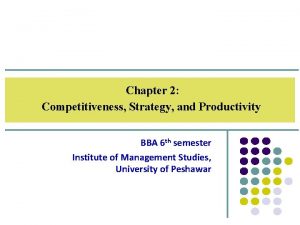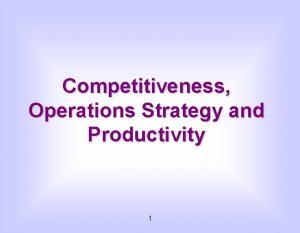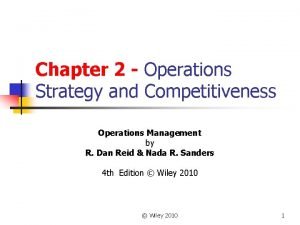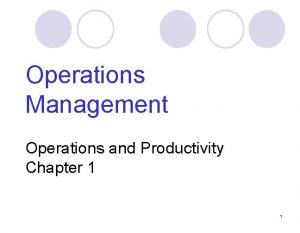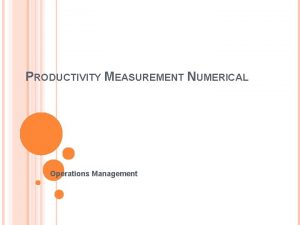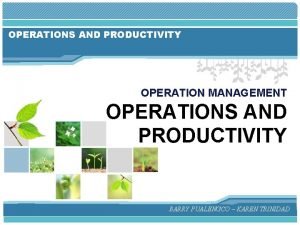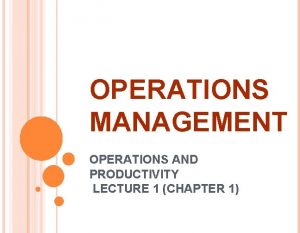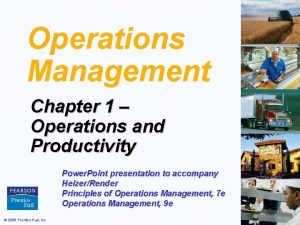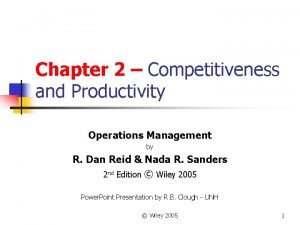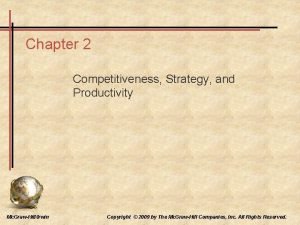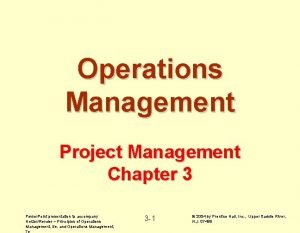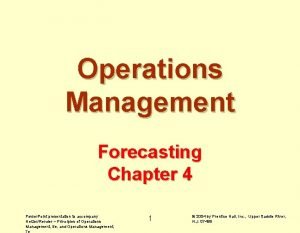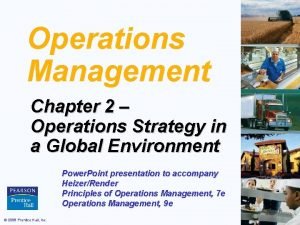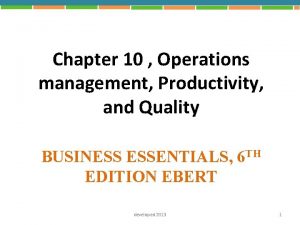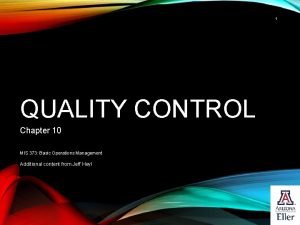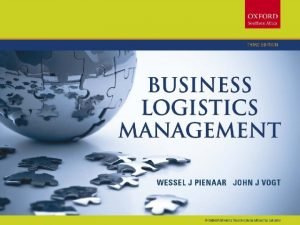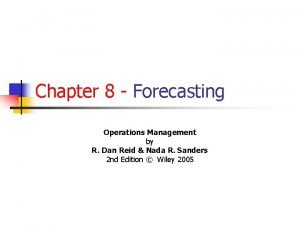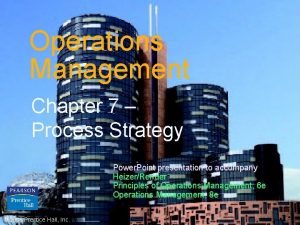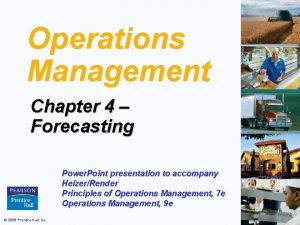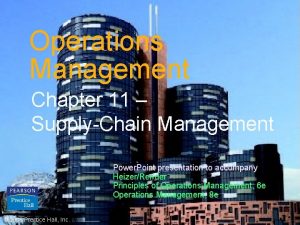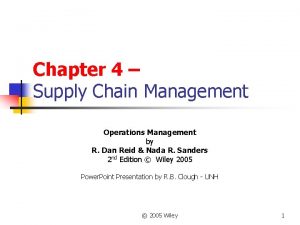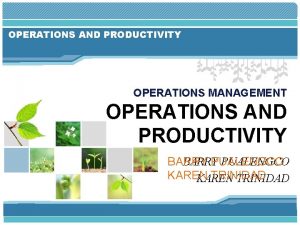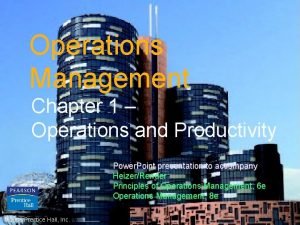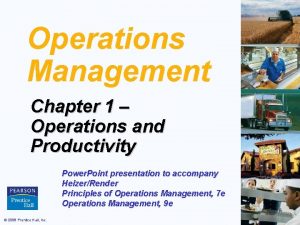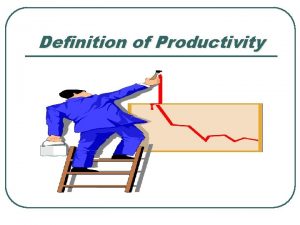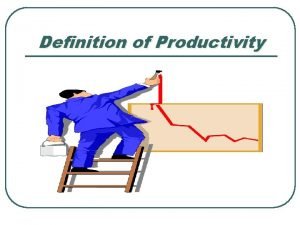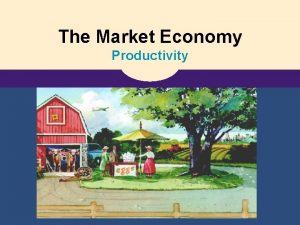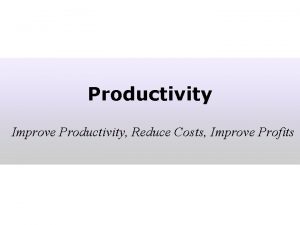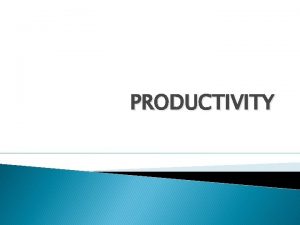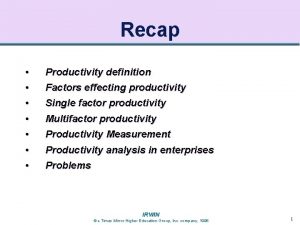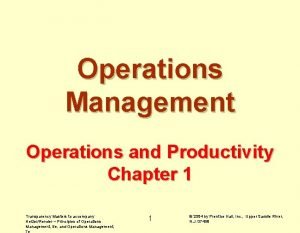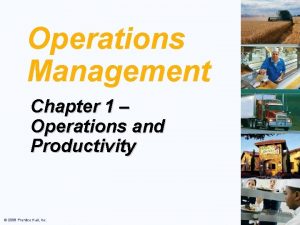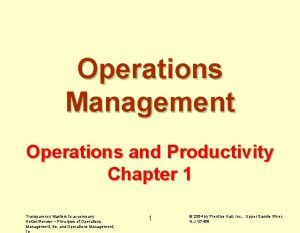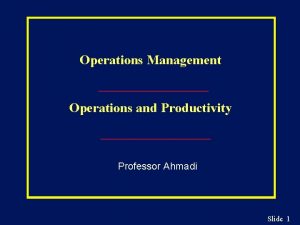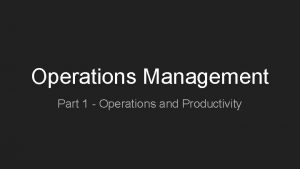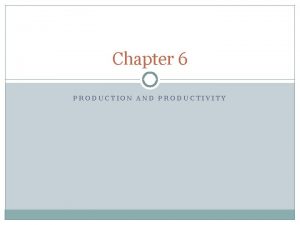Operations Management Operations and Productivity Chapter 1 Power





























- Slides: 29

Operations Management Operations and Productivity Chapter 1 Power. Point Presentation to accompany Operations Management, 6 E (Heizer & Render) 1 © 2001 by Prentice Hall, Inc. , Upper Saddle River, N. J. 07458

Outline ¨ Global company profile: Whirlpool ¨ What is Operations Management? The heritage of Operations Management ¨ Why study OM? ¨ What Operations Managers do ¨ ¨ Organizing to produce goods and services ¨ Where are the OM jobs? ¨ Exciting new trends in Operations Management ¨ Operations in the service sector ¨ The Productivity challenge Power. Point Presentation to accompany Operations Management, 6 E (Heizer & Render) 2 © 2001 by Prentice Hall, Inc. , Upper Saddle River, N. J. 07458

Learning Objectives When you complete this chapter, you should be able to: ¨ Identify or Define: Production and productivity ¨ Operations Management (OM) ¨ What operations managers do ¨ Services ¨ ¨ Describe or Explain: A brief history of operations management ¨ The future of the discipline ¨ Measuring productivity ¨ Power. Point Presentation to accompany Operations Management, 6 E (Heizer & Render) 3 © 2001 by Prentice Hall, Inc. , Upper Saddle River, N. J. 07458

Whirlpool Case Example ¨ Change in attitude - employees “live quality” ¨ Training - “use your heads as well as your hands” ¨ Flexible work rules ¨ Gain-sharing ¨ Global procurement ¨ Role of information/information technology 4 ¨ Adoption of a Worldwide strategy Power. Point Presentation to accompany Operations Management, 6 E (Heizer & Render) © 2001 by Prentice Hall, Inc. , Upper Saddle River, N. J. 07458

What Is Operations Management? ¨ Production is the creation of goods and services. Inputs, outputs, and a definite structure can be found. ¨ Operations management is the set of activities (business functions) that creates goods and services by transforming inputs into outputs (and activities that increases the value of these goods) Power. Point Presentation to accompany Operations Management, 6 E (Heizer & Render) 5 © 2001 by Prentice Hall, Inc. , Upper Saddle River, N. J. 07458

Significant Events in OM ¨ Division of labor (Smith, 1776) ¨ Standardized parts (Whitney, 1800) ¨ Scientific management (Taylor, 1881) ¨ Coordinated assembly line (Ford 1913) ¨ Gantt charts (Gantt, 1916) ¨ Motion study (the Gilbreths, 1922) ¨ Quality control (Shewhart, 1924) Power. Point Presentation to accompany Operations Management, 6 E (Heizer & Render) 6 © 2001 by Prentice Hall, Inc. , Upper Saddle River, N. J. 07458

Significant Events Continued ¨ CPM/PERT (Dupont, 1957) ¨ MRP (Orlicky, 1960) ¨ CAD ¨ Flexible manufacturing systems (FMS) ¨ Manufacturing automation protocol (MAP) ¨ Computer integrated manufacturing (CIM) Power. Point Presentation to accompany Operations Management, 6 E (Heizer & Render) 7 © 2001 by Prentice Hall, Inc. , Upper Saddle River, N. J. 07458

Why Study OM? ¨ OM is one of three major functions (marketing, finance, and operations) of any organization ¨ We want (and need) to know how goods and services are produced ¨ We want to know what operations managers do ¨ OM is such a costly part of an organization Power. Point Presentation to accompany Operations Management, 6 E (Heizer & Render) 8 © 2001 by Prentice Hall, Inc. , Upper Saddle River, N. J. 07458

What Operations Managers Do WE CAN FIND 5 CHARACTERISTICS: ¨ Plan: This process determines customer needs. ¨ Organize: This process also involves a set of cross-functional activities (marketing, operations, and engineering need to create products that customers want and value) Power. Point Presentation to accompany Operations Management, 6 E (Heizer & Render) 9 © 2001 by Prentice Hall, Inc. , Upper Saddle River, N. J. 07458

What Operations Managers Do ¨ Staff: This process involves managing all of the activities involved from the selection of raw materials vendors to the ultimate delivering and servicing of the product to the customer. ¨ Lead : The strategic planning process defines what the firm and its OM function wants to be and specifies what it must do to achieve its corporate goals. ¨ Control: Includes all supporting business 10 processes that are essential in all Power. Point Presentation to accompany Operations Management, 6 E (Heizer & Render) © 2001 by Prentice Hall, Inc. , Upper Saddle River, N. J. 07458

Tools of quality management Before you try to solve a problem, define it. Before you try to control a process, understand it. Before trying to control everything, understand it. Start by picturing the 11 process Power. Point Presentation to accompany Operations Management, 6 E (Heizer & Render) © 2001 by Prentice Hall, Inc. , Upper Saddle River, N. J. 07458

Process Thinking Tools ¨ 1. Identify and bound the process of interest ¨ 2. Identify and categorize the process activities ¨ 3. Document the process ¨ 4. Analyze the process and identify opportunities for improvement ¨ 5. Recommend appropriate changes to the process ¨ 6. Implement the changes Power. Point Presentation to accompany Operations Management, 6 E (Heizer & Render) 12 © 2001 by Prentice Hall, Inc. , Upper Saddle River, N. J. 07458

Ten Critical Decisions ¨ Service, product design ¨ Quality management ¨ Process, capacity design ¨ Location ¨ Layout design ¨ Human resources, job design. ¨ Supply-chain management ¨ Inventory management ¨ Scheduling ¨ Maintenance Power. Point Presentation to accompany Operations Management, 6 E (Heizer & Render) 13 © 2001 by Prentice Hall, Inc. , Upper Saddle River, N. J. 07458

Organizational Functions ¨Marketing ¨ Gets customers ¨Operations ¨ creates product or service ¨Finance/Accounting ¨ Obtains funds ¨ Tracks money Power. Point Presentation to accompany Operations Management, 6 E (Heizer & Render) 14 © 2001 by Prentice Hall, Inc. , Upper Saddle River, N. J. 07458

Where Are the OM Jobs? ¨ Technology/methods ¨ Facilities/space utilization ¨ Strategic issues ¨ Response time ¨ People/team development ¨ Customer service ¨ Quality ¨ Cost reduction ¨ Inventory reduction ¨ Productivity improvement Power. Point Presentation to accompany Operations Management, 6 E (Heizer & Render) 15 © 2001 by Prentice Hall, Inc. , Upper Saddle River, N. J. 07458

New Challenges in OM From ¨ Local or national focus ¨ Batch shipments ¨ Low bid purchasing To ¨ Global focus ¨ Just-in-time ¨ Supply chain partnering ¨ Lengthy product development ¨ Standard products ¨ Job specialization Power. Point Presentation to accompany Operations Management, 6 E (Heizer & Render) 16 ¨ Rapid product development, alliances ¨ Mass customization ¨ Empowered employees, © 2001 by Prentice Hall, Inc. , Upper Saddle River, N. J. 07458

Goods and Services ¨ A good or commodity in economics is any object or service that increases utility. ¨ A service is the non-material equivalent of a good. A service provision is an economic activity that does not result in ownership, and this is what differentiates it from providing physical goods. It is claimed to be a process that creates benefits by facilitating either a change in customers, a change in their physical possessions, or a change in their intangible assets. Power. Point Presentation to accompany Operations Management, 6 E (Heizer & Render) 17 © 2001 by Prentice Hall, Inc. , Upper Saddle River, N. J. 07458

Characteristics of Goods ¨ Tangible product ¨ Consistent product definition ¨ Production usually separate from consumption ¨ Can be inventoried ¨ Low customer interaction Power. Point Presentation to accompany Operations Management, 6 E (Heizer & Render) 18 © 2001 by Prentice Hall, Inc. , Upper Saddle River, N. J. 07458

Characteristics of Service ¨ Intangible product ¨ Produced & consumed at same time ¨ Often unique ¨ High customer interaction ¨ Inconsistent product definition ¨ Often knowledge-based ¨ Frequently dispersed Power. Point Presentation to accompany Operations Management, 6 E (Heizer & Render) 19 © 2001 by Prentice Hall, Inc. , Upper Saddle River, N. J. 07458

Goods Versus Services Goods Service ¨ Can be resold ¨ Can be inventoried ¨ Some aspects of quality measurable ¨ Selling is distinct from Power. Point Presentation to accompany Operations Management, 6 E (Heizer & Render) ¨ Reselling unusual ¨ Difficult to inventory ¨ Quality difficult to measure ¨ Selling is part of service 20 © 2001 by Prentice Hall, Inc. , Upper Saddle River, N. J. 07458

Goods Versus Services Continued Goods ¨Service Product is ¨ Provider, not transportable product is transportable ¨ Site of facility important for cost ¨ Site of facility important for customer contact ¨ Often easy to ¨ Often difficult to automate ¨ Revenue generated ¨ Revenue primarily from generated tangible product 21 primarily from intangible service. Power. Point Presentation to accompany Operations Management, 6 E (Heizer & Render) © 2001 by Prentice Hall, Inc. , Upper Saddle River, N. J. 07458

Development of the Service Economy U. S. Employment, % Share 80 Services as a Percent of GDP United States %70 60 Services 50 40 Industry 20 10 Canada 250 France 200 Italy 150 Britain 30 100 Japan Farming 0 1850 75 1900 25 U. S. Exports of Services In Billions of Dollars 50 W Germany 50 75 2000 1970 1991 40 50 60 70 Percent 0 1970 75 80 85 90 95 2000 Year 2000 data is estimated Power. Point Presentation to accompany Operations Management, 6 E (Heizer & Render) 22 © 2001 by Prentice Hall, Inc. , Upper Saddle River, N. J. 07458

The Economic System Transforms Inputs to Outputs Input s Land, Labor, Capital, Manageme nt Process Outputs The economic system transforms inputs to outputs at about an annual 1. 7% increase in productivity (capital 38% of 1. 7%), labor (10% of 1. 7%), management (52% of 1. 7%) Goods and Services Feedback loop Power. Point Presentation to accompany Operations Management, 6 E (Heizer & Render) 23 © 2001 by Prentice Hall, Inc. , Upper Saddle River, N. J. 07458

Productivity ¨ Measure of process improvement(Productivity refers to measures of output from production processes, per unit of input ) Productivity = Units produced Input used ¨ Represents output relative to input ¨ Productivity increases improve standard of living ¨ From 1889 to 1973, U. S. productivity 24 annual rate increased at a 2. 5% Power. Point Presentation to accompany Operations Management, 6 E (Heizer & Render) © 2001 by Prentice Hall, Inc. , Upper Saddle River, N. J. 07458

Measurement Problems ¨ Quality may change while the quantity of inputs and outputs remains constant ¨ External elements may cause an increase or decrease in productivity ¨ Precise units of measure may be lacking Power. Point Presentation to accompany Operations Management, 6 E (Heizer & Render) 25 © 2001 by Prentice Hall, Inc. , Upper Saddle River, N. J. 07458

Productivity Variables ¨ Labor - contributes about 10% of the annual increase ¨ Capital - contributes about 32% of the annual increase ¨ Management - contributes about 52% of the annual increase Power. Point Presentation to accompany Operations Management, 6 E (Heizer & Render) 26 © 2001 by Prentice Hall, Inc. , Upper Saddle River, N. J. 07458

Jobs in the U. S Power. Point Presentation to accompany Operations Management, 6 E (Heizer & Render) 27 © 2001 by Prentice Hall, Inc. , Upper Saddle River, N. J. 07458

% per year Productivity Growth 19711992 Labor Whole Economy Power. Point Presentation to accompany Operations Management, 6 E (Heizer & Render) Manufacturing 28 © 2001 by Prentice Hall, Inc. , Upper Saddle River, N. J. 07458

Service Productivity ¨ Typically labor intensive ¨ Frequently individually processed ¨ Often an intellectual task performed by professionals ¨ Often difficult to mechanize ¨ Often difficult to evaluate for quality Power. Point Presentation to accompany Operations Management, 6 E (Heizer & Render) 29 © 2001 by Prentice Hall, Inc. , Upper Saddle River, N. J. 07458
 Competitiveness, strategy and productivity reflection paper
Competitiveness, strategy and productivity reflection paper Productivity and competitiveness in operations management
Productivity and competitiveness in operations management Productivity and competitiveness in operations management
Productivity and competitiveness in operations management Operations and productivity chapter 1
Operations and productivity chapter 1 Productivity definition in operations management
Productivity definition in operations management Art binley has decided to look at his productivity
Art binley has decided to look at his productivity The ten critical decisions of operations management include
The ten critical decisions of operations management include Productivity definition in operations management
Productivity definition in operations management Productivity definition in operations management
Productivity definition in operations management The real lesson 21
The real lesson 21 Chapter 12 inventory management
Chapter 12 inventory management Unitless measure of productivity
Unitless measure of productivity Operations and quality management
Operations and quality management What is tqm
What is tqm Operations management chapter 3 ppt
Operations management chapter 3 ppt Operations management chapter 4 forecasting solutions
Operations management chapter 4 forecasting solutions Operations management chapter 2
Operations management chapter 2 Role of operations management
Role of operations management Chapter 3 operations management
Chapter 3 operations management Operations management chapter 10
Operations management chapter 10 Asq control chart
Asq control chart Chapter 8 operations management
Chapter 8 operations management Forecasting in operations management
Forecasting in operations management Crossover charts
Crossover charts Operation management chapter 4
Operation management chapter 4 Chapter 11 operations management
Chapter 11 operations management Job design continuum
Job design continuum Chapter 4 operations management
Chapter 4 operations management Chapter 2 operations strategy and competitiveness
Chapter 2 operations strategy and competitiveness Solar power satellites and microwave power transmission
Solar power satellites and microwave power transmission
